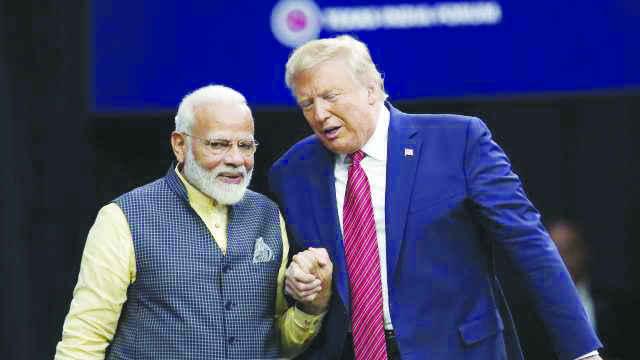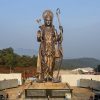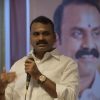Goa is abuzz with excitement as vintage bike and car owners, users, collectors and fans are decking […]

MODI, TRUMP RIG FACEBOOK!
In the News, Oct 17- Oct 23, 2020 October 16, 2020FEKU: The claims of Modi and Trump to mass support are based on rigged Facebook ratings. It is not human beings but robots who press the ‘Like’ button to inflate the followers of politicians who are sagging in their social network skill. Ankhi Das, Facebook Head in India, has admitted to manipulating Facebook in favour of Narendra Modi
By Joyojeet Pal
The popularity of our politician or any other public figure like an actor or musician is determined by the number of people to click the like button on their mobiles. It is not widely known that for a price Facebook robots will click as many numbers as you want to inflate your popular rating…….
While both leaders have helped create a spectre of interactive political communication that shields the politician from any real accountability, Trump has turned immaturity into a political doctrine.
Narendra Modi is several million Twitter followers and Facebook likes up on his soon-to-be American counterpart Donald Trump. Both leaders have changed political communication in important ways and social media has been central to their campaigns.
While it may seem intuitive to try and compare Trump with Modi because of their insurgent, anti-incumbent campaigns, there is a lot that separates the two campaigns. First, Modi had a clear unified party behind him. The party’s online presence fell decisively behind Modi through networks of following and in the propagation of his messages through retweets. Trump, on the other hand, ran what gravitated between a one-man show ignored by the Republican party to one often in direct opposition to the party line.
Second, Modi ran a disciplined, vetted campaign that featured well-crafted messaging, which rarely deviated from a consistent message. His rhetoric was generally cautious and careful not to rile anyone, except the occasional expedient antagonist – the UPA, Pakistan or Bangladeshi immigrants. Trump’s Twitter account on the other hand was frothing dribble of invective aimed equally much at those that he would likely have to stand close to were he to win the election. While Modi went so far as to generally steer clear of negative messaging even about those sections of the mainstream media that were most clearly seen as opposed to his candidature, Trump successfully slandered the very media sources seen as traditionally allied with the conservative right in the US.
On output, style, tenor, and organisation, it was Hillary Clinton that resembled Modi, not Trump.
Save for the elephant in the room, the eponymous ‘comments section’ of social media, populated by those that the respective men stood for. The unfortunate legacy of the two social media campaigns may well be the enabling of acrimony online from a dispersed web of followers. Unlike the political strongman of yore who could primarily swing party apparatchiks into action against dissent in the media, Trump and Modi emerged at a time when the affordances of distributed media allowed the vilification of the ordinary by the ordinary. Some of their most successful messages were the attacks.
Andre Gonawela, a University of Michigan undergraduate studying social media, raised an interesting comparison between the two leaders online – they both created sarcastic labels for political rivals. Trump’s rivals were ‘Crooked Hillary’, ‘Lyin’ Ted’ or ‘Little Marco’, Modi’s were ‘Shahzada’ or ‘Rahul Baba’ and ‘Madam’.
Labels can be an effective tool and work in a strange way in politics. They help infantilise, or even dehumanise the other, validating political attack through character dismissal. Modi’s reference to Rahul Gandhi as ‘baba’ infantilised him, but also placed him squarely as subordinate to his mother. The ‘madam’ moniker in turn used to suggest a supercilious foreign ‘memsaab.’ More pernicious was the use of ‘Shahzada’, the association of the term with ‘outside invaders’ was not lost on many.
Trump’s use of labels appeared diarrheic in their frequency, but were no less damaging. Lyin’ Ted helped further the discourse of his party rival Ted Cruz’s alleged untrustworthiness, Little Marco in a rather bullying fashion branded Marco Rubio as spluttering toady and Crooked Hillary became a clarion call for a bizarre investigation into what would eventually turn out to be fictitious crimes, effectively tried and condemned through social media.
But yet, the style of labelling has a message about political outreach in both campaigns and who were the intended ears of the messaging. Trump openly embraced the ‘shoot-from-the-hip’ American persona of unfiltered plain speak, ostensibly aimed at the mythical ‘average American’. The sarcasm inherent in terms like Shahzada on the other hand underlines the acerbic wit of a multi-layered affront delivered as an inside joke, which in repetition eventually claims the position of a slur. What made both particularly effective was that the use of labels and sarcasm made news outside of social media. Mainstream media in both countries helped popularise the terms that the politicians used to insult their opponents.
The use and success of sarcasm online is not surprising. Research has shown that in public communications, irony and sarcasm have higher emotional appeal than direct statements. Even when there is a trade-off with clarity, sarcasm offers the speaker more protection by virtue of the construction of irony being more allusive than precise. Indeed Trump more flagrantly, and eventually successfully used allusion than perhaps any other politician in modern history.
Modi’s use of sarcasm is arguably much more nuanced. The voice of measured wit stands as an alternative to the strongman politics he once stood for. Inherent in sarcasm is an ability for communicative politics that is a priori a clever, humorous substitute for the frontal attack. In this, the ability to change the nature of the discourse is valuable not only to Modi, but equally so for his follower who retweets that message, for that in turn is an advertisement for the retweeter’s voice. Not to mention, the sarcastic tone may be the only way to successfully use Dhoom 3 as a worthwhile popular culture reference in a tweet (see below) without coming across as having way too much time as a prime ministerial contender.
Shahzada came to Rajasthan without informing their CM & rode on a bike belonging to a history sheeter. Perhaps he was inspired by Dhoom 3. The power of Modi’s message is in the juxtaposition of the past he often refers to as being a train station tea seller, alongside the present as a selfie-clicking leader of a strong aspirational state. Sarcasm, through that frame, is a reminder that here before us is a leader who, when needed, can switch gears to a much more aggressive tone, but instead chooses restraint and humour. Sarcasm is as much a message from Modi as it is a message about him. Modi’s brand metamorphosis online has been relatively steady. Research has shown that Modi more or less stopped tweeting sarcastically, or even confrontationally after his election, and generally moved towards a much more statesman-like tone online.
Trump on the other hand has stayed much truer to his reality star persona post-election, offering a steady stream of tweets that end with an exclamation, or at least one that appears as an imaginary bubble over the head of the reader. No reasonable political commentator would claim that either Trump of Modi won an election thanks to social media, but their lasting legacy may be the reframing of direct communication between the leader and the electorate. Social media creates the spectre of interactive communication despite shielding the politician from accountable response.
Both leaders had voluminous mainstream media coverage despite doing their best to avoid direct interaction with members of the press. Both also capitalised on coverage on banalities and popular messaging rather than substantive policy discussion. The reporter asking hard questions may soon join the relics of journalistic past, as social media turns into the primary channel of manufactured output for citizen and press alike.
To this end, Trump has done more than given legitimacy to Brexit and Rodrigo Duterte. He has turned immaturity into political doctrine. Indians can rest assured that their leader cannot be accused of that, even when he looks longingly at a terracotta statue.
Coutersy:www.thewire.in















